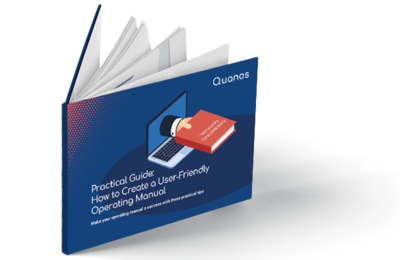Creating Operating Instructions – The New Practical Guide Is Here!
Sebastian Schiller, Software Trainer at Quanos, shares his expertise when it comes to creating user-friendly operating instructions in the new Quanos practical guide. In this interview he gives tips on how to do this and reveals what readers can expect from the downloadable practical guide.

What makes operating instructions user-friendly?
Sebastian Schiller: More than anything, consistency and structure. Both make operating instructions clearer and enable readers to find information more easily. In my opinion, the main problem with technical documentation is that users often cannot find the information they need fast enough. They usually become frustrated quickly when they have a problem with a product.
How can you create operating instructions that are standardized and structured?
At the document level, the reader should instantly know what they have in front of them. Are they operating instructions, instructions for use or installation instructions? At the chapter level, a structure is required that reflects the product life cycle. This means that it should be clear to the reader that they go to the “Operation” section if options appear on the screen they don't understand when the machine starts up, or to the “Troubleshooting” section if the machine is not working. Within a chapter, particular sequence patterns are helpful, so that readers can instantly distinguish actions they have to carry out from descriptions. Passive constructions and subordinate clauses should be avoided as far as possible. Standardized terminology should be used at the word level – in other words, I should use defined terms as a technical writer.

A range of standards define how operating instructions should be laid out. Do these kinds of rules restrict you or are they a useful aid for technical writers?
I view them as a guideline, but the tricky thing about them is that the standards are not specific enough when it comes to many day-to-day issues surrounding technical documentation. This means that there is room for interpretation. The standards also have nothing to say about the fundamental philosophical questions of technical documentation. For example, do I address someone directly with “you” or not? Or how should I structure sequences of actions? Although there are guidelines on the standards that provide recommendations, you still need to define several aspects yourself. This is what an internal company style guide is for.
Why is it important to create operating instructions that meet the standards?
Here is what the standards and guidelines have to say themselves: if the operating instructions are faulty, the product is also faulty, as the document forms part of the product. This could result in the customer using it as a reason to seek remediation and ultimately a replacement, in other words return of the product. Equally, the operating instructions become a tangible target should an accident occur. So, if the injured party suffered an electrical shock, one of the first questions asked will be, did the operating instructions give a sufficient warning of this hazard? Incorrect operating instructions open up the potential for complaints or even legal proceedings, which is why it is so important that you comply with standards.
What kinds of mistakes do you come across in operating instructions?
Common mistakes I see are different manners of addressing users, inconsistent structures – in other words, steps are presented inconsistently – and warnings that are not compliant with standards. This always comes down to the same issue, that no one has taken the time to think about how you should actually structure the operating instructions. They simply got started on writing them. In this case, I would really advise people to follow the standards and also to set rules internally – this makes writing instructions much easier.
How much help is a Content Management System such as SCHEMA ST4 when creating user-friendly operating instructions?
It saves technical writers doing a lot of tedious, repetitive work, meaning that they can focus on the essentials. Copying and pasting and the like are eliminated, meaning that the user can concentrate on creating the content. It also helps in creating a standardized content structure as well as defining and applying the terminology. Content can be reused and if something changes, I only need to modify it in one place. A Content Management System is hugely helpful whenever I have umpteen product variants or I have to provide the technical documentation in different languages.
Let’s talk about the new practical guide “How to create user-friendly operation instructions”. What does it have to offer from your point of view?
It is a perfect introduction into the topic, especially for those who are starting their careers after their studies, or for those who have changed career. We show the most important standards and discuss the content operating instructions have to contain. The practical guide contains lots of useful information on easy-to-understand language in technology and visual design, and it is also oriented toward practical aspects. Before I started working at Quanos as a trainer, I worked in technical documentation for many years. That’s why I know which areas can be problematic and it was important to me that it provides plenty of easy-to-use tips. I therefore strongly recommend that you download the practical guide!
Kerstin Smirr conducted the interview.

Make your operating manual a success with these practical tips
How can you create a user-friendly operating manual that meets more than just legal requirements? A document that provides customers and technicians with valuable information about your product in every situation, presented in an understandable and visually appealing way? We answer these questions in this practical guide.


